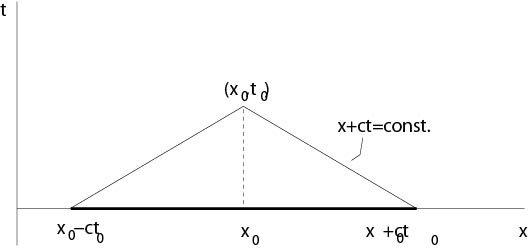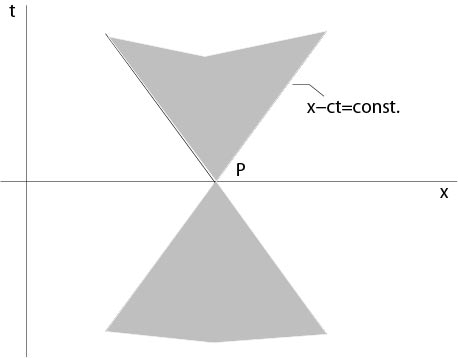4.1: One-Dimensional Wave Equation
- Page ID
- 2148
\( \newcommand{\vecs}[1]{\overset { \scriptstyle \rightharpoonup} {\mathbf{#1}} } \)
\( \newcommand{\vecd}[1]{\overset{-\!-\!\rightharpoonup}{\vphantom{a}\smash {#1}}} \)
\( \newcommand{\dsum}{\displaystyle\sum\limits} \)
\( \newcommand{\dint}{\displaystyle\int\limits} \)
\( \newcommand{\dlim}{\displaystyle\lim\limits} \)
\( \newcommand{\id}{\mathrm{id}}\) \( \newcommand{\Span}{\mathrm{span}}\)
( \newcommand{\kernel}{\mathrm{null}\,}\) \( \newcommand{\range}{\mathrm{range}\,}\)
\( \newcommand{\RealPart}{\mathrm{Re}}\) \( \newcommand{\ImaginaryPart}{\mathrm{Im}}\)
\( \newcommand{\Argument}{\mathrm{Arg}}\) \( \newcommand{\norm}[1]{\| #1 \|}\)
\( \newcommand{\inner}[2]{\langle #1, #2 \rangle}\)
\( \newcommand{\Span}{\mathrm{span}}\)
\( \newcommand{\id}{\mathrm{id}}\)
\( \newcommand{\Span}{\mathrm{span}}\)
\( \newcommand{\kernel}{\mathrm{null}\,}\)
\( \newcommand{\range}{\mathrm{range}\,}\)
\( \newcommand{\RealPart}{\mathrm{Re}}\)
\( \newcommand{\ImaginaryPart}{\mathrm{Im}}\)
\( \newcommand{\Argument}{\mathrm{Arg}}\)
\( \newcommand{\norm}[1]{\| #1 \|}\)
\( \newcommand{\inner}[2]{\langle #1, #2 \rangle}\)
\( \newcommand{\Span}{\mathrm{span}}\) \( \newcommand{\AA}{\unicode[.8,0]{x212B}}\)
\( \newcommand{\vectorA}[1]{\vec{#1}} % arrow\)
\( \newcommand{\vectorAt}[1]{\vec{\text{#1}}} % arrow\)
\( \newcommand{\vectorB}[1]{\overset { \scriptstyle \rightharpoonup} {\mathbf{#1}} } \)
\( \newcommand{\vectorC}[1]{\textbf{#1}} \)
\( \newcommand{\vectorD}[1]{\overrightarrow{#1}} \)
\( \newcommand{\vectorDt}[1]{\overrightarrow{\text{#1}}} \)
\( \newcommand{\vectE}[1]{\overset{-\!-\!\rightharpoonup}{\vphantom{a}\smash{\mathbf {#1}}}} \)
\( \newcommand{\vecs}[1]{\overset { \scriptstyle \rightharpoonup} {\mathbf{#1}} } \)
\( \newcommand{\vecd}[1]{\overset{-\!-\!\rightharpoonup}{\vphantom{a}\smash {#1}}} \)
\(\newcommand{\avec}{\mathbf a}\) \(\newcommand{\bvec}{\mathbf b}\) \(\newcommand{\cvec}{\mathbf c}\) \(\newcommand{\dvec}{\mathbf d}\) \(\newcommand{\dtil}{\widetilde{\mathbf d}}\) \(\newcommand{\evec}{\mathbf e}\) \(\newcommand{\fvec}{\mathbf f}\) \(\newcommand{\nvec}{\mathbf n}\) \(\newcommand{\pvec}{\mathbf p}\) \(\newcommand{\qvec}{\mathbf q}\) \(\newcommand{\svec}{\mathbf s}\) \(\newcommand{\tvec}{\mathbf t}\) \(\newcommand{\uvec}{\mathbf u}\) \(\newcommand{\vvec}{\mathbf v}\) \(\newcommand{\wvec}{\mathbf w}\) \(\newcommand{\xvec}{\mathbf x}\) \(\newcommand{\yvec}{\mathbf y}\) \(\newcommand{\zvec}{\mathbf z}\) \(\newcommand{\rvec}{\mathbf r}\) \(\newcommand{\mvec}{\mathbf m}\) \(\newcommand{\zerovec}{\mathbf 0}\) \(\newcommand{\onevec}{\mathbf 1}\) \(\newcommand{\real}{\mathbb R}\) \(\newcommand{\twovec}[2]{\left[\begin{array}{r}#1 \\ #2 \end{array}\right]}\) \(\newcommand{\ctwovec}[2]{\left[\begin{array}{c}#1 \\ #2 \end{array}\right]}\) \(\newcommand{\threevec}[3]{\left[\begin{array}{r}#1 \\ #2 \\ #3 \end{array}\right]}\) \(\newcommand{\cthreevec}[3]{\left[\begin{array}{c}#1 \\ #2 \\ #3 \end{array}\right]}\) \(\newcommand{\fourvec}[4]{\left[\begin{array}{r}#1 \\ #2 \\ #3 \\ #4 \end{array}\right]}\) \(\newcommand{\cfourvec}[4]{\left[\begin{array}{c}#1 \\ #2 \\ #3 \\ #4 \end{array}\right]}\) \(\newcommand{\fivevec}[5]{\left[\begin{array}{r}#1 \\ #2 \\ #3 \\ #4 \\ #5 \\ \end{array}\right]}\) \(\newcommand{\cfivevec}[5]{\left[\begin{array}{c}#1 \\ #2 \\ #3 \\ #4 \\ #5 \\ \end{array}\right]}\) \(\newcommand{\mattwo}[4]{\left[\begin{array}{rr}#1 \amp #2 \\ #3 \amp #4 \\ \end{array}\right]}\) \(\newcommand{\laspan}[1]{\text{Span}\{#1\}}\) \(\newcommand{\bcal}{\cal B}\) \(\newcommand{\ccal}{\cal C}\) \(\newcommand{\scal}{\cal S}\) \(\newcommand{\wcal}{\cal W}\) \(\newcommand{\ecal}{\cal E}\) \(\newcommand{\coords}[2]{\left\{#1\right\}_{#2}}\) \(\newcommand{\gray}[1]{\color{gray}{#1}}\) \(\newcommand{\lgray}[1]{\color{lightgray}{#1}}\) \(\newcommand{\rank}{\operatorname{rank}}\) \(\newcommand{\row}{\text{Row}}\) \(\newcommand{\col}{\text{Col}}\) \(\renewcommand{\row}{\text{Row}}\) \(\newcommand{\nul}{\text{Nul}}\) \(\newcommand{\var}{\text{Var}}\) \(\newcommand{\corr}{\text{corr}}\) \(\newcommand{\len}[1]{\left|#1\right|}\) \(\newcommand{\bbar}{\overline{\bvec}}\) \(\newcommand{\bhat}{\widehat{\bvec}}\) \(\newcommand{\bperp}{\bvec^\perp}\) \(\newcommand{\xhat}{\widehat{\xvec}}\) \(\newcommand{\vhat}{\widehat{\vvec}}\) \(\newcommand{\uhat}{\widehat{\uvec}}\) \(\newcommand{\what}{\widehat{\wvec}}\) \(\newcommand{\Sighat}{\widehat{\Sigma}}\) \(\newcommand{\lt}{<}\) \(\newcommand{\gt}{>}\) \(\newcommand{\amp}{&}\) \(\definecolor{fillinmathshade}{gray}{0.9}\)The one-dimensional wave equation is given by
\begin{equation}
\label{waveone}
\dfrac{1}{c^2}u_{tt}-u_{xx}=0,
\end{equation}
where \(u=u(x,t)\) is a scalar function of two variables and \(c\) is a positive constant. According to previous considerations, all \(C^2\)-solutions of the wave equation are
\begin{equation}
\label{wavegen}
u(x,t)=f(x+ct)+g(x-ct),
\end{equation}
with arbitrary \(C^2\)-functions \(f\) and \(g\)
The Cauchy initial value problem for the wave equation is to find a \(C^2\)-solution of
\begin{eqnarray*}
\dfrac{1}{c^2}u_{tt}-u_{xx}&=&0\\
u(x,0)&=&\alpha(x)\\
u_t(x,0)&=&\beta(x),
\end{eqnarray*}
where \(\alpha,\ \beta\in C^2(-\infty,\infty)\) are given.
Theorem 4.1. There exists a unique \(C^2(\mathbb{R}^1\times\mathbb{R}^1)\)-solution of the Cauchy initial value problem, and this solution is given by d'Alembert's1 formula
\begin{equation}
\label{waveform}
u(x,t)=\dfrac{\alpha(x+ct)+\alpha(x-ct)}{2}+\dfrac{1}{2c}\int_{x-ct}^{x+ct}\ \beta(s)\ ds.
\end{equation}
Proof. Assume there is a solution \(u(x,t)\) of the Cauchy initial value problem, then it follows from (\ref{wavegen}) that
\begin{eqnarray}
\label{ini1}
u(x,0)&=&f(x)+g(x)=\alpha(x)\\
\label{ini2}
u_t(x,0)&=&cf'(x)-cg'(x)=\beta(x).
\end{eqnarray}
From (\ref{ini1}) we obtain
\[f'(x)+g'(x)=\alpha'(x),\]
which implies, together with (\ref{ini2}), that
\[\begin{eqnarray*}
\label{12a} f'(x)&=&\dfrac{\alpha'(x)+\beta(x)/c}{2}\\
\label{12b}g'(x)&=&\dfrac{\alpha'(x)-\beta(x)/c}{2}.
\end{eqnarray*}\]
Then
\[\begin{eqnarray*}
f(x)&=&\dfrac{\alpha(x)}{2}+\dfrac{1}{2c}\int_0^x\ \beta(s)\ ds +C_1\\
g(x)&=&\dfrac{\alpha(x)}{2}-\dfrac{1}{2c}\int_0^x\ \beta(s)\ ds +C_2.
\end{eqnarray*}\]
The constants \(C_1\), \(C_2\) satisfy
\[C_1+C_2=f(x)+g(x)-\alpha(x)=0,\]
see (\ref{ini1}). Thus each \(C^2\)-solution of the Cauchy initial value problem is given by d'Alembert's formula. On the other hand, the function \(u(x,t)\) defined by the right hand side of (\ref{waveform}) is a solution of the initial value problem.
\(\Box\)
Corollaries. 1. The solution \(u(x,t)\) of the initial value problem depends on the values of \(\alpha\) at the endpoints of the interval \([x-ct,x+ct]\) and on the values of \(\beta\) on this interval only, see Figure 4.1.1. The interval \([x-ct,x+ct]\) is called {\it domain of dependence}.

Figure 4.1.1: Interval of dependence
2. Let \(P\) be a point on the \(x\)-axis. Then we ask which points \((x,t)\) need values of \(\alpha\) or \(\beta\) at \(P\) in order to calculate \(u(x,t)\)? From the d'Alembert formula it follows that this domain is a cone, see Figure 4.2.1. This set is called domain of influence.

Figure 4.2.1: Domain of influence
1 d'Alembert, Jean Babtiste le Rond, 1717-1783
Contributors and Attributions
Integrated by Justin Marshall.


